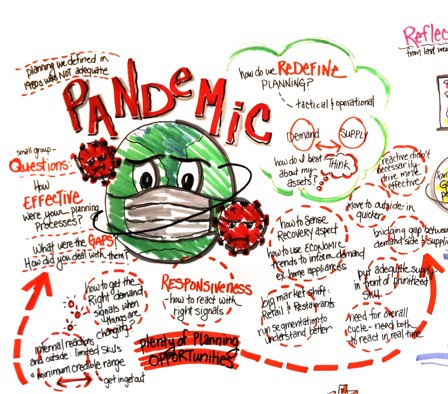The Covid-19 pandemic tested the global supply chain. While prior risk management disruptions occurred and quickly established a new normal, in the COVID-19 pandemic, the only normal is constant change. Like riding a bumpy road, the supply chain leader is riding the ups and downs of changing market conditions facing greater variability day-to-day. It will not be over soon. Expect a bumpy ride for the unforeseeable future.

Lessons from the pandemic offer us insights to build better. The status quo failed corporations. Here, based on interviews with supply chain leaders, I share lessons learned.
Lessons Learned.
The Failure of Existing Demand Planning Solutions. During the pandemic, supply chain leaders turned off their demand planning solutions. The reason? The systems–based on shipment and order data–were out of step with the market. The output was just not helpful.
Also, the solutions lacked flexibility. With fixed models and hard-wired data feeds, teams could not adjust the planning systems to use consumption data or market indicators.
Next Steps: Start to model demand based on market data to align the organization on baseline demand. (Baseline demand reflects market potential.) Start small and test and learn. Resist the temptation to place deeper analytics on top of existing data models. (E.g. Avoid implementing Aera on top of an existing SAP APO implementation.) Instead, rethink the model and the approach.
Re-implement demand planning, trade promotion management, and revenue/price management together to improve the baseline demand signal. This means building a cognitive engine to sense, learn, and adapt using market data for innovators.
Need For What-If Analysis. No company interviewed was able to successfully use their current what-if solutions to model pandemic impacts. Out of desperation, they turned to the use of descriptive analytics. While the industry is flush with terms like digital twin and what-if modeling, current applications were not equal to the need.
Next Steps. Companies need an easy-to-use sandbox deployment to visualize supply chain constraints and the impact of variability. We have too hard-wired solutions bolted into IT architectures to enable the flexibility needed by business leaders during times of high variability.
Using some of the new digital twin capabilities, build a sandbox for supply chain leaders to model supply chain impacts and publish results. I am currently working on a couple of case studies for this blog on how business leaders used digital twin modeling during the pandemic. While each is different in vendor selected and problem solved, what is common is the depth of modeling and the ability for business leaders to change the model with shifts in business conditions. The most successful used the digital twin to rationalize and visualize supply chain trade-offs in a sandbox environment (untethered to other applications).
The Emergence of Logistics as Constraint. Advanced planning evolved with a focus on modeling manufacturing constraints. Initially, the output was published to procurement to design strategic buying strategies. Over time, this changed. Procurement became an island–isolated from the demand signal except for MRP.
Advanced planning tools(APS) never considered the issues of logistics. Transporation planning evolved as a set of distinct applications separate from APS. The focus of the transportation suites was on cost mitigation and price negotiation. Availability of logistics was always assumed. This has changed.
With the contraction of air capacity and the unprecedented level of imports to the United States from Asia, logistics constraints grew in importance in the pandemic. Air expediting took on a new meaning in January, with air capacity down 18% and escalating prices. More and more cargo shifted to ocean transport until the container imbalances resulted in issues with “rolling the freight” from ship to ship despite confirmed bookings. With the rising costs of accessorial charges as the freight sat on the dock, moving freight by ocean container grew more problematic.
Dwell times grow as more and more ships sit in the ocean waiting to unload. The lack of chassis and the need to return empty containers to Asia paralyzes North American ocean freight.
Next Steps. Give logistics leaders a strategic seat at the table. Change the shift in visibility systems from tracking physical assets –vessel and container tracking– to shipment visibility. Most of the industry makes most of the visibility solutions from third-party logistics providers and technologists obsolete.
In addition, build a planning master data management system. Let me explain how this works. Record shipment times into a dynamic database for lead times (based on actual data) and ground planning models with this new logistics reality. (Check out some of the work that Blume Global is doing in this area.)
Watermelon Metrics Don’t Drive The Right Results. It Is Even Worse in the Pandemic. I love the metaphor of watermelon metrics. (This was a gift from a member of a group that I am facilitating.) In most organizations, there is a dashboard of functional metrics that shows all of the functions operating in the “Green” or acceptable levels until it comes to customer service. Customer service is red.
With customer service metrics showing “red,” the question becomes how we can be outperforming on functional metrics and underperforming in customer service? The issue is that traditional functional metrics drive underperformance—the greater the variability, the larger the gap.
What are functional metrics? Here are some examples:
- Manufacturing: Lowest manufacturing cost, Operational Equipment Effectiveness (OEE), and Asset Utilization.
- Procurement: Purchase price variance and procurement cost.
- Delivery: Lowest transportation cost, on-time shipment from shipper’s dock.
- Demand Planning: Weighted Mean Absolute Error (WMAPE)
How do they need to shift?
- Manufacturing: Schedule adherence and first-pass yield, focusing on the lowest total cost (the combination of all costs to deliver).
- Procurement: Supplier reliability, in-bound shipment reliability, supplier quality, and the lowest total cost (the combination of all costs to deliver).
- Delivery: Lowest total costs (the combination of all costs to deliver) and on-time shipment at the customer’s dock.
- Demand Planning: Forecast Value Added (FVA) and shifts in baseline demand.
The goal is to create a corporate balanced scorecard and tie functional metrics to the reliability of operations to deliver customer service. Digital twin modeling enables the potential of what is possible.
The Importance of Governance and Planning Clarity. Never before has it been more important to define a clear vision of supply chain excellence and be clear on governance–how to decide and what makes a good decision. In reactive environments, organizations forget the need for process discipline and after-action review. In Figure 1, for reference, I share the planning time horizon framework.
Figure 1. Planning Horizons
During the pandemic, companies became more reactive. Many tossed the concepts of planning out the window.
Next Steps: Focus on how to use technologies to make decisions. Build clear governance for each planning horizon on how to make a decision and practice emergency plan
Wrap-up
During the pandemic, companies became reactive –frequent meetings and emergency control rooms. Supply chain leaders, like firefighters, get an adrenaline rush from reactive behavior. The caution is that reactive behavior does not help the organization be more proactive. Use the pandemic experience to question the status quo and build better.
See You At the Supply Chain Insights Global Summit?
We will take the risk that everyone can get COVID shots and tests and do an in-person event in September. We will also have a virtual feed for those unable to travel.
In preparation, I am handpicking the speakers and finishing up the Supply Chains to Admire analysis for 2021. If you have a story you would like to share; please drop me an email at lora.cecere@supplychaininsights.com.
 Please mark your calendars to join us to think differently and Imagine the Supply Chain of the Future. We hope to see you there.
Please mark your calendars to join us to think differently and Imagine the Supply Chain of the Future. We hope to see you there.








